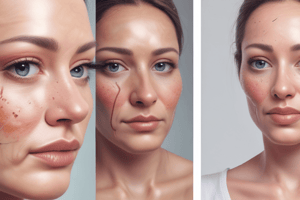Podcast
Questions and Answers
What is a closed wound?
What is a closed wound?
- No break in skin (swelling, bruise) (correct)
- Wound that extends all the way to SubQ tissue
- Break in skin or mucus membranes
- Wound caused by sharp objects
What characterizes an open wound?
What characterizes an open wound?
- Infection with pus
- Break in skin or mucus membranes (correct)
- No break in skin
- Involves epidermis
What is an acute wound?
What is an acute wound?
- Short duration of healing (correct)
- Wound caused by blunt force
- A collection of pus from bacteria
- Long-term delayed healing
Which of the following describes a chronic wound?
Which of the following describes a chronic wound?
What is the main characteristic of a clean wound?
What is the main characteristic of a clean wound?
Define a contaminated wound.
Define a contaminated wound.
What indicates an infected wound?
What indicates an infected wound?
What is a superficial wound?
What is a superficial wound?
What is the definition of an incision?
What is the definition of an incision?
What does granulation tissue look like?
What does granulation tissue look like?
Match the following wounds with their characteristics:
Match the following wounds with their characteristics:
Study Notes
Types of Wounds
- Closed Wound: No break in the skin, often presents as swelling or bruise.
- Open Wound: Involves a break in skin or mucous membranes, includes abrasions, lacerations, punctures, and compound fractures.
Wound Categories
- Acute Wound: Heals quickly through the phases of inflammation, proliferation, and maturation.
- Chronic Wound: Exhibits long-term delayed healing; all chronic wounds are infected, such as pressure ulcers and diabetic ulcers.
Wound Cleanliness
- Clean Wound: Uninfected with minimal inflammation, can be either open or closed.
- Clean-Contaminated Wound: Surgical incisions into gastrointestinal, genitourinary, or respiratory tracts.
- Contaminated Wound: Major breaks in asepsis, high infection risk from sources like accidents or animal bites.
- Infected Wound: Positive culture or bacterial presence, manifests with signs of infection like increased pain or warmth.
Wound Classification by Thickness
- Superficial Wound: Limited to the epidermis, often due to shearing, friction, or burns.
- Partial-Thickness Wound: Extends through the epidermis into the dermis, but not fully through.
- Full Thickness Wound: Extends to subcutaneous tissue.
- Penetrating Wound: Involves visible bones, ligaments, tendons, or internal organs.
Specific Types of Wounds
- Abrasion: Scraping away the superficial skin layers.
- Abscess: Accumulation of pus from bacterial invasion.
- Contusion: A severe bruise resulting from trauma.
- Crushing Wound: Resulting from strong compressive force, may not break skin.
- Incision: Deliberate wound caused by sharp instruments.
- Laceration: Tissue torn with jagged margins.
- Puncture: Caused by sharp objects, increasing risk of infection.
Ulcers
- Arterial Ulcers: Round and dry, pale appearance due to inadequate blood circulation causing ischemia.
- Venous Ulcers: Wet and ruddy, associated with blood pooling and impaired circulation.
- Pressure Ulcer: Results from prolonged pressure causing tissue damage.
Pressure Ulcer Stages
- Stage I: Redness without blanching.
- Stage II: Partial thickness, extending through epidermis to dermis.
- Stage III: Full thickness, including subcutaneous tissue.
- Stage IV: Penetrating, exposing deep structures like bones and organs.
Healing Indicators
- Granulation Tissue: Appears beefy red, indicative of healing and new blood vessel formation.
- Epithelial Tissue: New epidermis, pink or pearly white, may form around a healing wound.
- Clean, Non-Granulating Tissue: Smooth, shiny appearance, indicates delayed healing.
Debridement and Skin Conditions
- Slough: Soft, stringy tissue requiring debridement.
- Eschar: Thick, leathery tissue that is dry, needs debridement.
- Maceration: Softening of surrounding skin from excessive moisture.
- Undermining: Skin around the wound feels mushy, indicating potential extension.
- Blistering: Fluid present under the skin.
- Crepitus: Trapped air under the skin, causing crackling sensation.
- Erythema & Swelling: Redness suggesting tissue risk of compromise.
Studying That Suits You
Use AI to generate personalized quizzes and flashcards to suit your learning preferences.
Description
Explore the various types and classifications of wounds, including closed and open wounds as well as acute and chronic wounds. This quiz also delves into wound cleanliness and thickness, providing insight into how wounds are categorized based on their characteristics. Test your knowledge on wound care and management!




